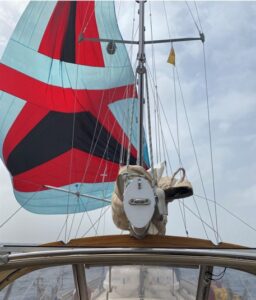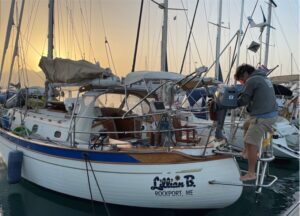Arrival in Cabo Verde
Wednesday, Feb 2, 2022
Latitude 16o 53’ N
Longitude 25o 00’ W
Mindelo Marina, Cabo Verde
Arrival in Cabo Verde
Tuesday morning at 3 AM we were sixty miles from our planned landfall in Mindelo, Cabo Verde, sailing at slightly over four knots. Four knots would normally be very satisfactory but the math was not in our favor. Sixty nautical miles divided by four knots in speed translated to fifteen more hours of sailing. 3 AM plus fifteen hours implied an arrival after six in the evening, too close to sunset for comfort. We did not want to negotiate the entrance to the wreck filled harbor of Mindelo in the dark. If we didn’t get there before dark, we would have to hold our position off the coast until sunrise. To gain some margin, we motor-sailed for the next six hours and by noon the next day we were back under sail, within comfortable striking distance. The plan was to continue sailing until three pm at which time we would restart the engine if needed and motor the remaining distance to our destination.
With time left for sailing, we decided to raise the spinnaker. That decision nearly cost us a day. The spinnaker is a large balloon of a sail that flies like a kite out in front of the boat. It is the best sail to use when the winds are light and over the stern. But, like a kite Charlie Brown, it takes a level of skill to keep it flying.

Flying the spinnaker on the approach to Cabo Verde
We’d flown the spinnaker briefly a few days earlier. Denise was at the helm successfully keeping it inflated when she called out to us below that it had a rip. A six-foot tear was slowly propagating upward from the foot of the sail. Before it got any worse, we doused it by pulling down the “sock”, a sleeve that envelops the spinnaker in a tube so it can be easily dropped into the sail bag. The next day, using a roll of sail tape left over from 2005, a cross-shaped patch was made and the sail repackaged for deployment. As we approached landfall, the wind was around 15 knots from the northeast. Arriving at Cape Verde with the spinnaker proudly flying seemed only appropriate, especially since we were in an unofficial race with another sailboat about a mile off our port side. For about twenty minutes the spinnaker was flying beautifully, adding at least a knot to our speed. And then she wrapped around the forestay, not once but several times. All efforts to unwrap it only made it worse. We then loosened the halyard in an attempt to drop the head of the sail so it could be awkwardly dragged in hand-over-hand back into the boat. Releasing the top of the spinnaker has to be done with extreme caution, because an unleashed six-story sail flailing in the wind carries tremendous power. To be on the wrong side of a line or the sail itself could result in serious injury. I’m not sure how, but eventually it freed itself enough that heading down wind allowed the sail to stream out safely in front of the boat as Burke and Brimmer hauled her in. Failing that, we would have had to endure the embarrassment of entering port with a spinnaker wrapped around the forestay. And we’d already lost the race to our neighboring sailboat.
Now with all sails down and secured, we increased the engine to 1500 rpm. We’d missed our planned “bingo” time of 3 PM but at 1500 rpm our speed was up to 5 knots, and we would arrive with half an hour to spare before sunset. Our plan was to anchor off the Marina and check in the next day. As we approached the harbor, we called the marine police on channel 16, as recommended, but with no response. We next called the Mindelo Marina on channel 72 and they came back immediately. We were prepared to drop anchor but, as an afterthought, I asked if they had a mooring available. I was thinking in terms of the floating balls common in the US. They were thinking in terms of a med-mooring, where one end of the boat is secured to the dock and the other end to a line running to a submerged anchor point 30 or so feet out from the dock. They directed us to come in. With little time to contemplate how to make the approach, the crew transitioned from anchoring mode and quickly rigged the docking lines and fenders for a dock landing. We came in bow first. The dockhands secure the two bow lines and handed us the anchor line to run back to stern. Our crew secured it to a cleat, pulled the line taut, and we were securely moored.
The only problem was that Lillian’s bow strut was protruding well over the dock. The dock hands contemplated the situation for a minute or two and then asked us to turn her around. As I’ve often noted in my blogs, backing Lillian is an un-relaxed exercise in trying to control which way she might go. But, to make a long story short, with the help of the crew moving fenders and calling out how close I was to various object, we backed in without hitting anything and were securely moored.
Our next task was to understand what we needed to do as far as checking in with the authorities. On approaching Cabo Verde, we had raised the yellow quarantine flag as was standard procedure even before COVID. Having arrived, we asked the dockhands what we needed to do as far as biosecurity. They seemed surprised at the question and focused instead on pointing out the location of the bathrooms and showers, and the floating Tiki bar was at the end of the dock. That was fine with us. The sun was setting behind the ridge to our west, weakly visible through the haze of sand blowing in off the Sahara. We would take full advantage of the Marina facilities and then check in officially the next day.

Landfall: Stepping off the stern at the Mindelo Marina